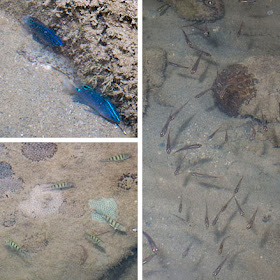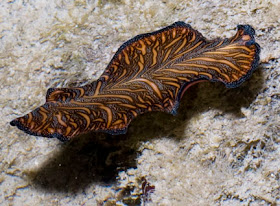Among the 'reefiest' shores on the mainland, I had a quick look at this stretch of Tanah Merah that was hit by the oil spill nearly two years ago. There were lots of different kinds of hard corals!
Like this large Bracket mushroom coral topped with a fan worm, with a large Copperband butterflyfish (Chelmon rostratus) hiding under it.
This is amazing! I think it's a Cabbage coral (Trachyphyllia geoffroyi) that I rarely come across. At first I thought it was another brain coral.
The special corals I saw today were a small mushroom coral (Family Fungiidae), a well formed blue Ringed plate coral, a tiny Carnation coral (Pectinia sp.) and a nicely growing colony of encrusting plate montipora coral (Montipora sp.).
There was a small Cauliflower coral (Pocillopora sp.) colony, my first time seeing it on Tanah Merah. And three well formed Brain coral (Family Mussidae) colonies. These finds almost made up for the fact that I couldn't find the Acropora coral (Acropora sp.) colony.
I saw three small Anemone corals (Goniopora sp.) colonies (top row) and many small Flowery disk coral (Turbinaria sp.) colonies, all of them seemed fine.
Favid corals (Family Faviidae) remain the most common hard coral that I saw today. There were many patches of Zebra coral (Oulastrea crispata), and many small to large colonies of other Favid corals in various colours and patterns.
I noticed some of the small colonies of Pore corals (Porites sp.) had bleached portions or were rather white.
Some larger Pore coral colonies had a kind of 'skin' that was peeling off.
But most of the large Pore corals were healthy. The white narrow shapes are apparently made by fishes that nibble on the coral.
The patch of leathery soft coral (Family Alcyoniidae) is still large!
Today, I saw many Frilly sea anemones (Phymanthus sp.) when usually I would only see one or two. I also saw one Swimming anemone (Boloceroides mcmurrichi) and near the seawall, one Haddon's carpet anemone (Stichodactyla haddoni) with a pair of Five-spot anemone shrimps (Periclimenes brevicarpalis). I couldn't find a single Haddon's carpet anemone on the higher rocky area. One my last trip here in February, I saw about ten of them. Oh dear. I wonder what happened to them.
I came across three Common cerianthids (Order Ceriantharia).
I saw these two Ball tip corallimorphs which are not true sea anemones.
There were also several small patches of Button zoanthids (Zoanthus sp.), two small colonies of Sea mat zoanthids (Palythoa tuberculosa) and one small colony of Broad zoanthids (Palythoa mutuki).
As usual, I get to see more fishes during a predawn trip. As soon as the sun rises, all the fishes hide away. There were many Cardinalfishes (Family Apogonidae) and gobies (Family Gobiidae) and other fishes that I have yet to figure out.
Today, there were lots of the little blue fishes probably young damselfishes (Family Pomacentridae). There were also lots of cardinalfishes (Family Apogonidae) and small striped Bengal sergeants (Abudefduf bengalensis). I also saw the nose tip of one Brown-spotted moray eel (Gymnothorax reevesii) hiding in its burrow.
I still haven't figured out what this pretty blotchy fish is.
One reason why I'm nervous about exploring Tanah Merah is because it is infested with stonefishes. Today, I only spotted one of these Hollow-cheeked stonefish (Synanceia horrida). Can you see him?
Here he is! It is hard to spot them and very unfortunate to step on one of them. So it is important to watch your step on Tanah Merah.
There's another well camouflaged fish in this photo. Can you spot it? It's the Painted scorpionfish (Parascorpaena picta), which were plentiful today.
I saw three of these flatfishes! I think they are Large-tooth flounders (Family Paralichthyidae).
I came across a school of Lined eeltail catfishes (Plotosus lineatus).
Today, I saw three Persian carpet flatworms (Pseudobiceros bedfordi)! These animals can swim for a short distance by undulating the edges of their flat bodies.
I saw many clumps of Green gum drop ascidians, in some areas they were quite thick!
There were plenty of Gong-gong snails (Strombus turturella). I notice they seem to form pairs when the one in the front is laying her tangled string of eggs. I saw many of these tangled strings on the shore today.
There were many Black lipped conch (Strombus urceus), some of them were also in pairs. Also many Oval moon snails (Polinices mammila), living Fan clams (Family Pinnidae), Common whelks (Nassarius livescens). Bazillion snails (Batillaria zonalis) only covered a small part of the rockier areas. I also saw an empty Fig snail shell (Ficus variegata).
I saw about 20 Common sea stars (Archaster typicus) on the sandy stretches. There were signs of birds large and small, hunting on the shore.
For the first time since the oil spill, I came across tiny Sand dollars (Arachnoides placenta)!
Other interesting sightings included, a large Mud crab (Scylla sp.), also many fanworms, the Pink puff ball sponge (Oceanapia sagittaria) and a little brittlestar. There were lots of Swimming crabs (Family Portunidae) of all kinds with a lot of small to medium-sized Flower crabs (Portunus pelagicus).
There were many small patches Spoon seagrass (Halophila ovalis), with tiny leaf blades and heavily covered in epiphytes. Besides the usual one small patch of Tape seagrass (Enhalus acoroides) in deeper water, I came across a larger patch of them further away. How nice! The most abundant seaweed today was Mermaid's fan (Padina sp.) as well as Knobbly red seaweed (Gracilaria salicornia). I saw a few clumps of Sargassum seaweed (Sargassum sp.) and some tiny patches of other kinds of seaweeds.
Another glorious sunrise! Today, I had the shore all to myself. There were no other people fishing on the shore.
It's amazing that this wide variety of marine life have settled on these artificial shores at Tanah Merah! There are still signs of crude on the shore, although less obvious. A kind of haze stirs up with each footstep, there's scum on some parts of the water in the lagoon, and some parts of the shore had patches of thin brown scum.
As usual, there's some litter on the high shore. Fortunately, this will be taken care of during the International Coastal Cleanup Singapore's Earth Day clean up this coming Saturday. More details. Bravo for ICCS!
More about the oil spill on this blog and on the Oil spill facebook page.

































